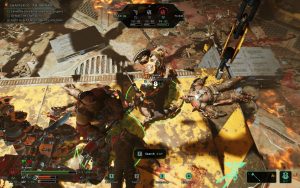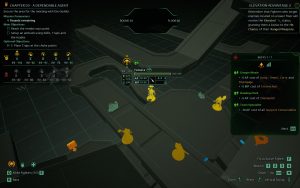Warhammer’s Fantasy Battle franchise is experiencing a massive resurgence, not for the first time in its forty-year history.
High elves on square bases are changing hands at silly prices on Warhammer exchange sites, Age of Sigmar: Indomitus sold out instantly and volumes of the Black Library are filling up my Audible feed, so I’m not surprised to see Focus Home Interactive keen to push out another video game.
Necromunda: Underhive Wars, is a turn-based tactical game developed by Rogue Factor. The title is inspired by the miniatures game still prominent on the shelves at your local Warhammer shop, and involves taking part in skirmishes between the gangs that live in the Ant City. The 40th millennium, in which it is set, seems possibly worse than 2020 — but let’s see what happens between now and Christmas.
Warhammer 40k is supported by a decaying empire fuelled by hate and steroids, in which constant war rages, involving several factions including the Empire’s Spacemarines battling the forces of Chaos battling, sleek aliens the Eldar, and the always amusing greenskins. In this relentless struggle, the planet Necromunda has suffered the sad fate of being used as a forge for imperial weapons, a task that has reduced the cities to a formless mass of metal and scrap — a moribund and polluted land where only the strongest survive, whose architecture closely resembles Blackpool 2020.
 There’s no distinction between good and evil here and the gangs swarming in the slums are, I suspect, distinctly less glamorous than those we will see in Cyberpunk 2077, all sporting tattoos, steroid-enhanced physiques and cybernetic grafts, probably discarded by the imperial armies. To survive, they must recover discarded supplies and search for lost ancient artefacts to sell on the black market. All this is part of the typical day for the Goliath, Escher and Orlock gangs (previously, I used to play as the Scavy gang, which will no doubt be included in the DLC).
There’s no distinction between good and evil here and the gangs swarming in the slums are, I suspect, distinctly less glamorous than those we will see in Cyberpunk 2077, all sporting tattoos, steroid-enhanced physiques and cybernetic grafts, probably discarded by the imperial armies. To survive, they must recover discarded supplies and search for lost ancient artefacts to sell on the black market. All this is part of the typical day for the Goliath, Escher and Orlock gangs (previously, I used to play as the Scavy gang, which will no doubt be included in the DLC).
Andy Chambers, Warhammer’s veteran writer, penned the campaign which unfolds through fifteen linear missions. These, unfortunately, have the feel of long tutorials rather than a coherent campaign, but are linked together by some nice-looking cut-scenes, in which you literally choke on the putrid air of Necromunda. It is a shame this attention to detail is not followed throughout the rest of the game, as it’s hard to ignore the stilted character animations, random roaming of AI-controlled gangs and unimaginative sound design.
There’s everything you would expect included in the narrative, which is not short on betrayal, gore and honour, all cemented together by the fervour and fanaticism typical of Warhammer 40k. Unfortunately, the quality of the missions is punctured by somewhat trivial objectives, which don’t really support the epic scope of the cut-scenes.
Other problems emerge right from the beginning of the game with the mechanics, which are quite hard to gets to grips with and not as well explained as I would have expected considering their complexity. After learning basic moves and how to engage, no explanations of additional tactics are offered, and it’s easy to fail a mission if you’re aren’t a turn-based veteran. Necromunda: Underhive Wars might lose players through frustration and that’s a shame; with so much random damage inflicted, it’s easy to feel out of your depth. But if you don’t give up you will eventually start to become familiar with the maps, weapons and complex system of rules.
 Unlike many tactical games, the maps in Necromunda are not divided into the classic hexagons, and the action takes place in a more open setting. In each match, a maximum of five units are deployed, which are activated alternately between the various teams involved in battle.
Unlike many tactical games, the maps in Necromunda are not divided into the classic hexagons, and the action takes place in a more open setting. In each match, a maximum of five units are deployed, which are activated alternately between the various teams involved in battle.
Each pawn is equipped with a predetermined amount of action points and movement points, to be spent at will to attack, move and interact with the environment. The scenarios stand out for their verticality, a characteristic taken directly from the physical miniatures game, and are dotted with numerous elements such as pulleys, explosive cylinders, bridges to blow up, traps and defensive barricades, which all contributes to making these environments alive and dynamic.
Each turn, you choose one of your gang members to activate and the ganger with the highest initiative acts first. This is a key element of the tactical gameplay, as you get the chance to pick off weakened enemies or retreat and heal your own members. The use of mines, disabling pathways and fixing broken elements all play a part in getting that victory. Overwatch and Ambush (shooting or hand-to-hand combat attacks) are provoked when an enemy comes into range, and are vital to success because you don’t want to be wasting action points or taking unnecessary damage. Using the tactical map or pressing CTRL is super-important if you don’t want to walk blindly into danger.
Another sore point for me is the third-person view behind the characters, which flickered and was sometimes very confusing. The AI struggles to read points of interest, which are often ignored or exploited in inappropriate moments and ways. The artificial intelligence moves the enemies in a way that often leaves one baffled, but is quick to take advantage of their slow and clumsy responses of the opposing units, especially in battles against multiple teams. Hopefully, some of your club-mates bought the game, so you can experience the game how it was meant to be played — versus a living and breathing, socially distanced human.
 Anarchy also seems to have been applied to the UI. By pressing a button, enemies and objects to interact with are highlighted on the screen, but you are never 100 per cent sure of their position — often the icons are lost in the background, are inexplicably small or even vanish.
Anarchy also seems to have been applied to the UI. By pressing a button, enemies and objects to interact with are highlighted on the screen, but you are never 100 per cent sure of their position — often the icons are lost in the background, are inexplicably small or even vanish.
This, combined with the choice of colour-palette, means the game lacks any sense of coherent visual communication skills. But Necromunda: Underhive Wars does have a saving grace and this is the Operations game mode. It guarantees ongoing playability, as it allows you to create and modify your own gangs as you like, just like in the miniatures game. Your gang can be customized down to the smallest of details. Just like the famous 28mm miniatures, the units have an infinite number of aesthetic customisations — I’ll always be a fan of a face tattoo, to match my resting bitch face expression.
Necromunda: Underhive Wars is a bit of a frustrating mess, somewhat like 2020, and definitely a reflection on this part of the Warhammer 40k world. But I worry too much frustration will alienate players, who will give up and miss out on the well-written campaign and rich strategic content.
